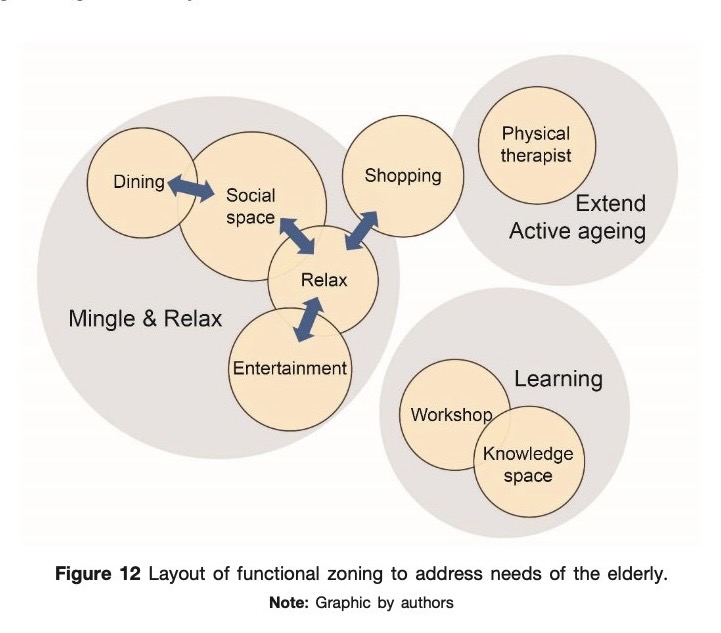Behaviors of the Elderly at Shopping Malls and Facility Management to Address Their Needs
Main Article Content
Abstract
This research aims to study the demographic, social, economic, health, and behavior data of the elderly who spend their time at shopping malls. It also examines the physical condition of shopping malls’ interiors in relation to the ministerial regulation prescribing accessible facilities for persons with disabilities and the elderly B.E. 2548 (2005), as well as analyzing the management of the space to suit the use by elderly in Bangkok. Structured interviews and onsite surveys were employed for the sampled groups at MBK Center and Chamchuri Square. The findings showed the key quality that attracts the seniors to the shopping malls are their locations. The majority of the seniors spending time at the shopping malls are of retirement age (60 – 69 years) who often are found gathered in areas with more seats and without a time limit (e.g., food court), talking with friends, shopping, and relaxing. Overall physical conditions of the shopping malls were properly organized for elderly people as seen from availability of ramps, escalators, elevators. This research includes suggestions including: operators should design and improve facilities in accordance with the ministerial regulation prescribing accessible facilities for persons with disabilities and the elderly B.E. 2548 (2005). The operator may consider setting up some co-working spaces to be specific areas for the elderly during times when they use the space in large numbers; or make it an intergenerational space suitable for the elderly and children to proactively create a point of sale for the mall.
Downloads
Article Details

This work is licensed under a Creative Commons Attribution-NonCommercial-NoDerivatives 4.0 International License.
All material is licensed under the terms of the Creative Commons Attribution 4.0 International (CC-BY-NC-ND 4.0) License, unless otherwise stated. As such, authors are free to share, copy, and redistribute the material in any medium or format. The authors must give appropriate credit, provide a link to the license, and indicate if changes were made. The authors may do so in any reasonable manner, but not in any way that suggests the licensor endorses you or your use. The authors may not use the material for commercial purposes. If the authors remix, transform, or build upon the material, they may not distribute the modified material, unless permission is obtained from JARS. Final, accepted versions of the paper may be posted on third party repositories, provided appropriate acknowledgement to the original source is clearly noted.
References
Cheang, M. (2002). Older adults’ frequent visits to a fast-food restaurant: Nonobligatory social interaction and the significance of play in a “third place”. Journal of Aging Studies, 16(3), 303-321. https://doi.org/10.1016/S0890-4065(02)00052-X
Department of Older Persons. (2019). Sathānakān phūsūngʻāyu Thai Phō̜ .Sō̜ . 2561 [Situation of the Thai elderly 2018]. Institute for Population and Social Research, Mahidol University and Foundation of Thai Gerontology Research and Development institute (TGRI). https://www.dop.go.th/download/knowledge/th1586350958-261_0.pdf
Eisenberg, R. (2017). 9 keys to a happy retirement; what the experts say, plus 8 great retirement books. Emporia Presbyterian Manor. Retrieved April 3, 2020, from www.emporiapresbyterianmanor.org/post/9-keys-to-a-happy-retirement
Jackie, K. Y. C. (2013). Projecting sustainable living environment for an ageing society: The case of Hong Kong. Procedia Environmental Sciences, 17, 675-684.
Jarutach, T. (2008). Universal design. Chulalongkorn University.
McLeod, D. S. (2007). Maslow’s hierarchy of needs. Simply psychology. Retrieved February 22, 2020, from www.simplypsychology.org/maslow.html
Ministerial regulation prescribing accessible facilities for persons with disabilities and the elderly B.E. 2548. (2005, July, 2). Royal Thai Government Gazette. Vol.122, part 52a. pp.4-19.
Ministerial regulation prescribing accessible facilities for persons with disabilities and the elderly (No. 2) B.E. 2564. (2021, March 4). Royal Thai Government Gazette. Vol.138, part 16a. pp.19-29.
Ongkulna, A. (2016, May 26). When Thai families are not the same. Bangkokbiznews. http://www.bangkokbiznews.com/news/detail/69979
Ritchie, H., & Roser, M. (2018). Urbanization. Our World in Data. Retrieved February 19, 2020, from http://ourworldindata.org/urbanization
The Bureau of Registration Administration. (2019). Bangkok population. Department of Provincial Administration, Ministry of Interior.
World Health Organization. (2002). Active ageing: A policy framework. World Health Organization (WHO). www.who.int/ageing/publications/active_ageing/en/
World Health Organization. (2007). Global age-friendly cities : A guide. World Health Organization (WHO). www.who.int/ageing/publications/Global_age_friendly_cities_Guide_English.pdf
Yamane, Taro.(1967). Statistics, an introductory analysis (2nd Ed.). Harper and Row.


